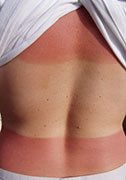- Skip Storing This Everyday Product in the Fridge Door
- Green Tea + B3 Pairing May Boost Brain Health
- Navigating Your Midlife Crisis: Embracing New Possibilities
- City Raccoons Showing Signs of Domestication
- Mapping the Exposome: Science Broadens Focus to Environmental Disease Triggers
- One Week Less on Social Media Linked to Better Mental Health
- Your Brain Changes in Stages as You Age, Study Finds
- Some Suicide Victims Show No Typical Warning Signs, Study Finds
- ByHeart Formula Faces Lawsuits After Babies Sickened With Botulism
- Switch to Vegan Diet Could Cut Your Greenhouse Gas Emissions in Half
Fewer U.S. Teens Using Sunscreen, Study Finds


The number of U.S. teens using sunscreen dropped nearly 12 percent in the last decade, a new report shows.
During that same time period, the number of teens using indoor tanning beds barely decreased. Both indoor tanning and failure to use sunscreen increase the risk of skin cancers, including deadly melanomas, the researchers noted.
“Unfortunately, we found a decrease in the overall percentage of teens who reported wearing sunscreen, from 67.7 percent in 2001 to 56.1 percent in 2011,” said lead researcher Corey Basch, an associate professor in the department of public health at William Paterson University in Wayne, N.J.
“Using sun-protective behaviors like applying sunscreen and avoiding intentional exposure to tanning devices will be key [to lowering cancer risk],” she added.
Use of indoor tanning devices by white girls decreased only slightly, from 37 percent in 2009 to 29 percent in 2011, she said.
The reasons for the decreased use of sunscreen among teens aren’t clear, Basch said, but she thinks future research should focus on finding out why.
“High school years are important years that can impact the future,” Basch said. “High school students are starting to make decisions for themselves. This research and other research suggest that adolescents continue to put themselves at risk.”
The report was published in the August issue of Preventing Chronic Disease, a publication of the U.S. Centers for Disease Control and Prevention.
Dr. Jeanine Daly, a dermatologist at North Shore-LIJ Health System in Manhasset, N.Y., said she was surprised at the drop in sunscreen use despite all the warnings about UV exposure leading to skin cancer.
“It’s still in vogue to have that suntanned color,” she said.
Daly thinks that the message that sun exposure can lead to skin cancer is still not getting through, especially to young girls. “No matter how hard we’ve been trying to get that message out, we need to keep at it and work harder,” she said. “The bottom line is that skin cancer is largely preventable.”
The best sunscreens are those that protect against both UVA and UVB rays. “Both are involved in skin cancer,” she said.
An effective sunscreen should contain a physical sunscreen such as zinc or titanium dioxide and a chemical sunscreen, she said. “The best sunscreen is one that contains zinc, because it covers both UVA and UVB rays,” Daly said.
“The most important thing to remember about sunscreen is that it doesn’t last very long,” she added. Sunscreen needs to be applied every two hours, Daly said.
In addition, it takes a lot of sunscreen to be fully protected, Daly explained. “The average tube of sunscreen is usually only four to six ounces — that should last maybe a day at the beach, but for a lot of people it lasts the entire season. We are just not using enough,” she said.
For the study, researchers used the Youth Risk Behavior Surveillance System to collect data on the use of sunscreen and tanning devices from a sample of U.S. high school students.
More information
Visit the U.S. National Cancer Institute for more on skin cancer.
Source: HealthDay
Copyright © 2025 HealthDay. All rights reserved.










